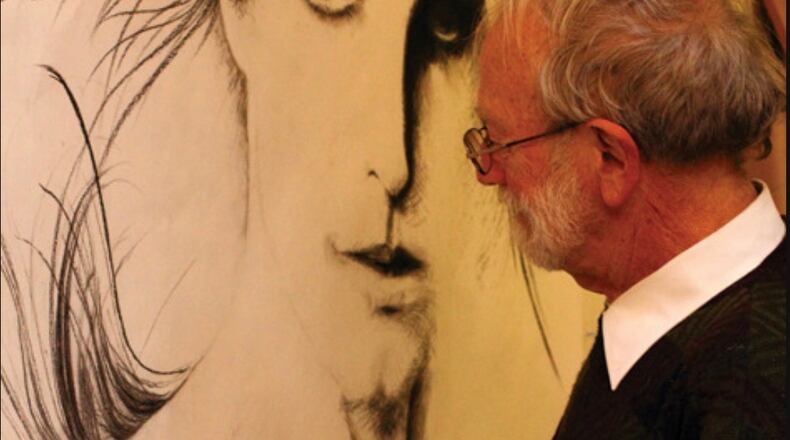Mary Jane Warren Stone saw a piece of art created by Lincoln Stone before she ever met him.
She found it “gruesome.”
The threatening 50-foot high cockroach which creeped Mary Jane out was part of a billboard he painted for a pest control company. It loomed above the juncture of Peachtree and Roswell Roads in the late 1970s.
Mary Jane, also an artist, subsequently met Stone, her future husband, when she interviewed him for a job. She found a portfolio of his work “dazzling,” in sharp contrast to her earlier visceral reaction.
The job hand-painting billboards for Turner Advertising served as a launching pad for the well-regarded and prolific artist. Stone created thousands of paintings, sculptures, clay figures, bronzes and wood carvings over more than 40 years. He also helped restore sections of the well-known Battle of Atlanta panorama that hangs at the Atlanta History Center.
Lincoln Stone, 79, passed away from complications of an earlier stroke March 24. He’s survived by his wife, Mary Jane Warrren Stone, brothers Dr. John R. and Samuel S. Stone and their spouses. A memorial service is set for 2 p.m. April 28 at Northbrook United Methodist Church, 11225 Crabapple Road in Roswell.
Stone grew up in Miami, but his life took a turn during military service in Germany. Feeling a creative pull, he got acquainted with the arts and crafts director at his military base, said Mary Jane.
John Stone recalled “The guy asked him, ‘If you could do anything you wanted, what would you do?’”
“Lincoln told him, ‘I want to a be an artist, but I can’t draw.’ The director told him, ‘That’s not a good reason. You can learn to draw.’”
Credit: Andy Sharp / AJC
Credit: Andy Sharp / AJC
Stone learned and went on to earn undergraduate and master’s degrees in the arts from Florida schools. He relocated to Atlanta and landed the Turner job before he began freelancing — creating paintings, carvings, sculptures and ceramics, which were sold in galleries or by commission.
Stone set up shop in a studio just off Marietta Square, looking every inch the artist, bearded and paint-splattered and dressed in his trademark white shirt and jeans.
His public art ranged from a giant steel globe on the former Southern Polytechnic State University campus, now part of Kennesaw State University, to a life-sized carving of literary character Uncle Remus for a library.
But perhaps his most-seen work doesn’t have his name on it. He restored the treetops, sky and clouds in upper portions of the massive painting depicting the 1864 Battle of Atlanta. The painstaking project commenced after the panorama was moved from the Cyclorama at the Atlanta Zoo to a new home at the Atlanta History Center. The 130-plus-year-old painting’s top sections had deteriorated.
Said longtime friend and patron Jay Block, “It was a major project and I felt initially it might be more than he could handle. But he did a great job.”
Block brainstormed with Stone on other projects, including casting a series of bronze, sculpted ballerinas.
“He wanted to do them as nudes,” recalls Block. “I said, ‘No, no, you have to put clothes on the ballerinas,’” arguing that that would extend their marketability.
Stone dutifully added clothing. Unfortunately they sold only middling well, as ballerina art flooded the market at the time.
Stone eschewed the idea of relentless self-marketing. At the same time he sought to command attention with his work, once telling The Atlanta Journal-Constitution “I don’t like people walking by my stuff. I’m not going to bother doing it if nobody’s going to look at it.”
Stone also sought to — in a manner of speaking — hook people with his art. He created intricately-detailed giant trout flies with hooks made of wood and feathers made of copper that were both realistic and deceptively soft-looking.
One hangs above the mantle of longtime friend James Austell’s North Carolina lodge while another was sold to a sporting goods store.
Pop culture also fascinated him. In that space, he painted a stark series of contemporary glamor women he called “Chelsea Girls.” Such was his interest in art that he once flew to New York and connected with pop culture guru Andy Warhol.
“He was creative and versatile,” said Austell. “He was the quintessential artist with a lot of passion about art and life.” His quizzed people on their lives, forging friendships with those he found interesting.
Those friends will be on full display at his memorial, said Mary Jane Stone. “There will be college professors and lawyers and bikers at the funeral. It will be a wonderful array of human souls because that’s who he attracted.”
Credit: Jason Getz / Jason.Getz@ajc.com
Credit: Jason Getz / Jason.Getz@ajc.com
About the Author
The Latest
Featured


